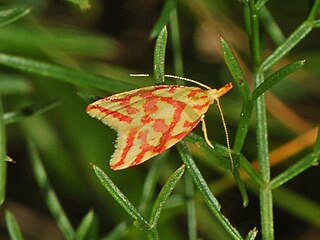Related Research Articles

Dophla evelina, the red-spot duke, is a species of brush-footed butterfly found in Cambodia and South and Southeast Asia. Many subspecies are accepted. The species was first described by Caspar Stoll in 1790.

Hypercallia citrinalis is a moth of the family Depressariidae. It is found in Europe, Asia Minor, Georgia, Armenia, Azerbaijan, Mongolia and southern Siberia.
Agonoxena miniana is a moth of the family Agonoxenidae. It is found on Java.
Dichomeris oceanis is a moth in the family Gelechiidae. It was described by Edward Meyrick in 1920. It is found in south-eastern Siberia, Japan, China, Korea and Taiwan.
Kiwaia aerobatis is a moth in the family Gelechiidae. It was described by Edward Meyrick in 1924. It is found in New Zealand.
Stenoma iostalacta is a moth of the family Depressariidae. It is found in Peru.
Eclecta is a monotypic moth genus in the family Depressariidae. Its only species, Eclecta aurorella, has been found in the Australian state of New South Wales. Both the genus and species were first described by Edward Meyrick in 1883.
Enchocrates phaedryntis is a moth in the family Depressariidae. It was described by Edward Meyrick in 1888. It is found in Australia, where it has been recorded from Western Australia.
Peritornenta bacchata is a moth in the family Depressariidae. It was described by Edward Meyrick in 1914. It is found in Australia, where it has been recorded from Queensland and New South Wales.
Gonionota militaris is a moth in the family Depressariidae. It was described by Edward Meyrick in 1914. It is found in Colombia.
Hypercallia niphocycla is a moth in the family Depressariidae. It was described by Edward Meyrick in 1926. It is found in Colombia.
Hypercallia chionopis is a moth in the family Depressariidae. It was described by Edward Meyrick in 1916. It is found in French Guiana.
Hypercallia halobapta is a moth in the family Depressariidae. It was described by Edward Meyrick in 1930. It is found in Brazil.
Hypercallia citroclista is a moth in the family Depressariidae. It was described by Edward Meyrick in 1930. It is found in Brazil.
Hypercallia alexandra is a moth in the family Depressariidae. It was described by Edward Meyrick in 1909. It is found in Peru.
Hypercallia cyathopa is a moth in the family Depressariidae. It was described by Edward Meyrick in 1913. It is found in Colombia.
Hypercallia orthochaeta is a moth in the family Depressariidae. It was described by Edward Meyrick in 1913. It is found in Peru.
Hypercallia psittacopa is a moth in the family Depressariidae. It was described by Edward Meyrick in 1912. It is found in Colombia.
Antaeotricha orthriopa is a species of moth in the family Depressariidae. It was described by Edward Meyrick in 1925. It is found in Brazil.
Antaeotricha notogramma is a species of moth in the family Depressariidae. It was described by Edward Meyrick in 1930. It is found in Brazil (Amazon).
References
- ↑ "Hypercallia Stephens, 1829" at Markku Savela's Lepidoptera and Some Other Life Forms.
- ↑ Transactions of the Entomological Society of London 1911 (4): 700
 This article incorporates text from this source, which is in the public domain .
This article incorporates text from this source, which is in the public domain .